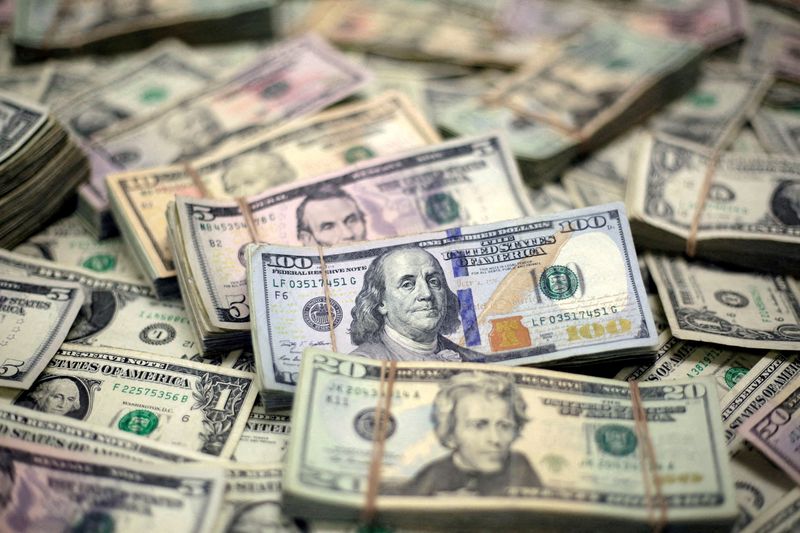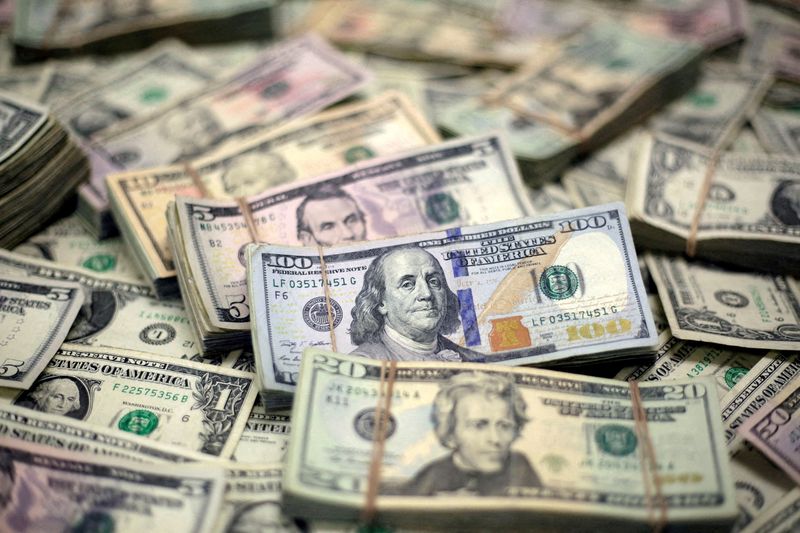
By Ankur Banerjee and Medha Singh
SINGAPORE/LONDON (Reuters) -The dollar eased from near seven-week highs against major currencies on Tuesday after investors assessed the outlook for U.S. rate cuts, even as geopolitical tensions in the Middle East continue to support the currency’s safe-haven appeal.
The euro inched 0.2% higher to $1.099225, not far from the seven-week low of $1.09515 hit last week. The pound was at $1.31, after hitting a three-week low of $1.30595 on Monday.
Traders have drastically shifted their expectations of monetary easing from the Federal Reserve this year. A strong jobs report last week gave credence to Fed Chair Jerome Powell, who has said the central bank would stick to its usual quarter-percentage-point rate reductions after it began its easing cycle with a super-sized cut in September.
“A lot of readjustment on the dollar is on the back of the idea that the Fed is not going to cut by 50 basis points anytime soon,” said Nick Rees, senior FX market analyst at Monex Europe.
“We’re no longer worried about the U.S. dropping into recession this year.”
Federal Reserve Bank of New York President John Williams, a permanent vote of the Fed’s rate-setting Committee, echoed Powell’s comments, telling the Financial Times in an interview that he doesn’t see the September move “as the rule of how we act in the future.”
Markets are no longer fully pricing in a rate cut in November and are ascribing around a 90% chance of a 25-basis-point reduction, the CME FedWatch tool showed. Just 50 bps of easing is priced in by December, down from more than 70 bps a week earlier.
That has kept the dollar on the front foot and helped the currency surge to a multi-week highs against the euro, sterling and the yen. The yen, however, clawed back some of the losses on Tuesday as rising geopolitical worries led investors to a flight towards safe-haven assets.
The dollar index, which measures the U.S. currency against major rivals, slipped 0.2% to 102.31.
“We could see the USD take another leg higher on CPI later this week and you could see a further readjustment in some of the rhetoric out of the Fed becoming a little bit more hawkish,” Monex Europe’s Rees added.
Investor focus this week will be on U.S. inflation report, due on Thursday, and minutes from the Fed’s September meeting scheduled to be released on Wednesday.
“If soft enough, Thursday’s CPI update could eventually help calming the Fed doves’ nerves and prevent the U.S. dollar from stepping into the medium-term bullish consolidation zone against many majors,” said Ipek Ozkardeskaya, senior analyst at Swissquote Bank.
“If not, the no-November-cut pricing could take off, and that would mean higher yields, a stronger U.S. dollar across the board, weaker other currencies, and some negative pressure on equity valuations.”
The benchmark 10-year U.S. Treasury yield remained above 4%, having touched the level on Monday for the first time in two months as traders curtailed wagers on super-sized rate cuts. [US/]
Meanwhile, China equity markets returned with a strong open after a week-long holiday break, but capped some gains as optimism around stimulus measures wavered a bit on lack of details.
The yuan eased a bit on dollar strength, with the onshore yuan weakening to 7.0521 per dollar.
The yen climbed 0.4% to 147.668 per dollar, after slumping to a seven-week low of 149.10 on Monday as comments from new Japanese Prime Minister Shigeru Ishiba cast doubts over how aggressive the BOJ would be in raising rates in the near term.

Ishiba stunned markets last week when he said the economy was not ready for further rate hikes, an apparent about-face from his previous support for the BOJ unwinding decades of extreme monetary stimulus.
In other currencies, the Australian dollar slid to its lowest since Sept. 16 of $0.6715, after minutes from the latest meeting of the nation’s central bank sounded slightly dovish. The Aussie was last down 0.5% at $0.67280.
This post is originally published on INVESTING.




